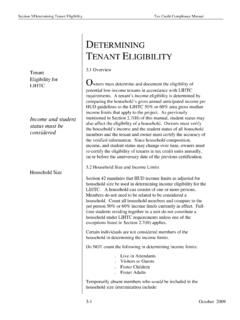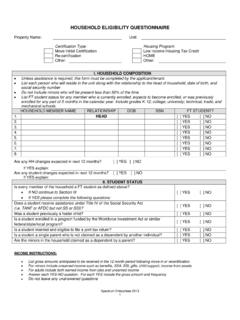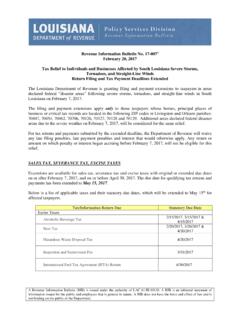Transcription of Section 2/Compliance Issues Tax Credit Compliance Manual
1 Tax Credit Compliance Manual Section 2/Compliance Issues 2-1 October 2009 Compliance Issues General Compliance U nlike any other federal housing program, the LIHTC program is administered by the IRS. The key to the entire tax Credit program, as well as an owner s ability to claim the full amount of tax credits allocated to the project, is continuous Compliance with federal and state LIHTC regulations throughout the Compliance period. The two fundamental components of Compliance are as follows: n Tax Credit units must be rented to households that are income eligible at move-in; n Rent must be restricted according to the maximum limits imposed by using the appropriate formula and income limits. An LIHTC project may have both tax Credit units (low-income units) and market (unrestricted rent) units, or it may have 100% tax Credit units. The project may also have nonresidential units specified in the LIHTC application and designated in the extended Low-Income Housing Commitment.
2 The income eligibility and restricted rent requirements apply only to the low-income units. These Issues will be discussed in more detail later in this Manual . Each Allocating Agency or their Authorized Delegate must monitor owners to ensure properties are in Compliance . The IRS requires that all findings of noncompliance, whether corrected or not, must be reported. A leading cause of noncompliance stems from the owner s failure to inform management of the specific regulatory commitments that have been made. Once credits have been allocated for a property, it is imperative that management be given copies of all regulatory and extended use documents to keep on file, including the Tax Credit Application, IRS Form(s) 8609 [ Section 10], and Certificates of Occupancy. CHFA requires that these documents be inserted into Section 1 of this Manual and always be readily available for review by your monitoring agency.
3 The following make up CHFA s regulatory documents: Important Compliance Factors Income eligible and rent restricted Note: Keep key documents available to everyone involved in keeping your property in Compliance . These include but are not limited to: 8609s Regulatory Agreement Training/Educational Materials Tax Credit Compliance Manual Section 2/Compliance Issues 2-2 October 2009 n Tax Credit Application n Notice of LIHTC Reservation n CHFA Carryover Allocation Agreement of LIHTC n extended Low-Income Housing Commitment n Copies of original executed, signed 8609s n Utility Allowance Documents (updated annually) n Declaration of Restrictive Covenants for Low-Income Housing Tax Credits n Limited Partnership Agreement n Certificate of Occupancy Additional key Issues are as follows: A. Allocation year As previously stated in Section 1, different Compliance regulations are in force depending on the year the tax Credit allocation was awarded.
4 The most important Compliance issue is that all monitoring/ Compliance is based on the year of allocation. The first two numbers of the Building Identification Number is the allocation year. Maintain a record of this date. B. Compliance by building All monitoring/ Compliance is a building issue . Records must be kept by building and by unit number, not by project or alphabetical order by tenant. Every LIHTC building receives a separate IRS Form 8609 and is assigned its own BIN (Building Identification Number). Required annual reports must be submitted by BIN. C. Placed-in-service date (PIS) For the LIHTC, a building s placed-in-service date initiates the start of Compliance monitoring for that building. Each building has only one placed-in-service date for new construction or rehabilitation credits. It is possible to have the same or different dates for different buildings.
5 For new construction, this date is the certificate of occupancy date the date on which the building is ready and available for its specifically assigned function, , the date on which the first unit in the building is certified as being suitable for occupancy in accordance with state or local law. [ Section 19] It is the date when the first unit in a building could be occupied, not when it was occupied. For rehabilitation of an existing building, the owner selects any date within a 24-month period over which rehab expenditures are aggregated. The placed-in-service (PIS) Allocation year Recordkeeping by building Monitoring begins when building places in services To be eligible for credits, a unit must be rented to an income eligible tenant. It must be occupied on a non-transient basis. For Rehab: A temporary Certificate of Occupancy can be used as the Placed In Service Date.
6 Tax Credit Compliance Manual Section 2/Compliance Issues 2-3 October 2009 Eligible basis equals allowable development costs Note: Market apartments are included in eligible basis. Be sure to include them when completing your end of year reporting. date is recorded on the 8609 form for each building. Be sure you have documentation to back up the PIS date for every building in your project. It is important to note: If you have Section 8 tenants, as in a HUD project based property, you must certify your tenants income eligible before you can claim the unit as a tax Credit unit. You cannot rely on old certifications (previous year) for this purpose. If you will have both acquisition credits and re-hab credits, and you have performed a Tenant Certification for the Acquisition PIS date, you may rely on that certification and are not required to complete another certification for the re-hab PIS date.
7 D. Eligible basis Eligible basis consists of (1) the cost of new construction, (2) the cost of rehabilitation, or (3) the cost of acquisition of existing buildings acquired by . Only the adjusted basis of the depreciable property may be included in the eligible basis. The cost of land is not included in adjusted basis. [General Explanation of the Tax Reform Act] Eligible basis includes the cost of low-income units, facilities for use by the tenants ( , common areas, elevators, corridors, roofs) and other facilities reasonably required by the project. The allocable costs of tenant facilities such as swimming pools, other recreational facilities, and parking areas may be included provided there is no separate fee for the use of these facilities and they are made available on a comparable basis to all tenants in the project. Costs of the residential rental units in a building which are not low-income units may be included in eligible basis only if such units are not above the average quality standard of the low-income units.
8 Rehabilitation costs may not be included in eligible basis if such expenditures improve any unit beyond comparability with the low-income units. Eligible basis does not include commercial space. Any change in the eligible basis that results in a decrease in the qualified basis of the project is noncompliance that must be reported to the IRS. See Section Tax Credit Compliance Manual Section 2/Compliance Issues 2-4 October 2009 Compliance period begins when credits are claimed Minimum number of LIHTC units required Criteria for tax Credit unit Keep first year records for 21 years E. Initial Credit period Owners may initially claim credits for the year that the building is placed in service or may defer claiming credits until the close of the following year. It is important for management to know when the credits were or will be claimed for the first time because the Compliance period runs fifteen (15) years starting with the first year credits are claimed.
9 The owner makes the election for the initial Credit period on each building s Form 8609. Once made, the election is irrevocable. Credits may not be claimed until the minimum set-aside is met. F. Minimum set-aside (MSA) Also an irrevocable election, the minimum set-aside establishes both the minimum number of low-income units to be maintained in a project and the applicable income limit for households to qualify for all tax Credit units. See discussion in Section G. Qualified LIHTC unit A low-income unit qualifies for the tax Credit when the following conditions are met: n Tenant eligibility verified and certified n Restricted rent n Nontransient residency n Unit suitable for occupancy n Unit recorded as LIHTC unit n Tenant eligibility re-certified annually: by third party process for mixed-use properties and by self-certification process for 100% LIHTC properties n Available to the public on a non-discriminatory basis Units meeting these requirements may be counted in the qualified basis for tax Credit purposes (See Section ).
10 H. Recordkeeping requirements IRS regulations list the LIHTC recordkeeping and record retention requirements for owners to follow to maintain Compliance . Project owners and managers should be familiar with this list and understand that required records could be subject to monitoring at any time. In addition, the first year records must be kept for 21 years. It is strongly recommended that these original documents be stored in a secure fireproof and waterproof location. Tax Credit Compliance Manual Section 2/Compliance Issues 2-5 October 2009 Minimum Set-Aside 20/50 or 40/60 to qualify for Credit Multiple building vs. building-by-building Minimum Set-Aside Election T he most critical Compliance issue for a low-income housing tax Credit project is the minimum set-aside (MSA) requirement. In order for an owner to claim tax credits, a project must have a minimum number of qualified tax Credit units.











